Words Amicia de Moubray Photographs Glen Charter, Neil Brown
‘You have to be fit and agile to be a thatcher, as you have to hop all over the place,’ says master thatcher Glen Charter.
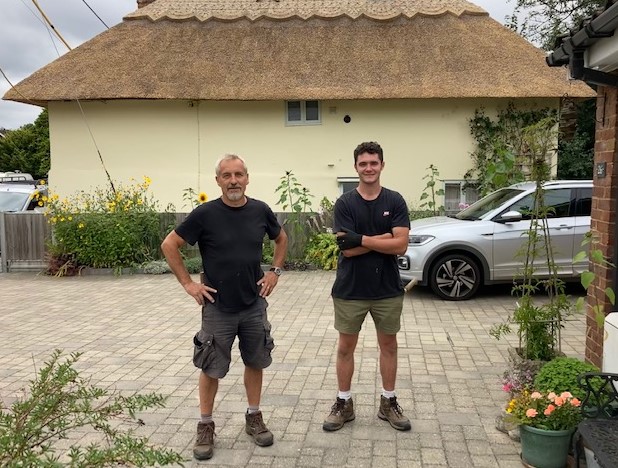
Master thatcher, Glen Charter and his apprentice, Richard Seaman standing proudly in front of their recently completed thatched roof in Newnham
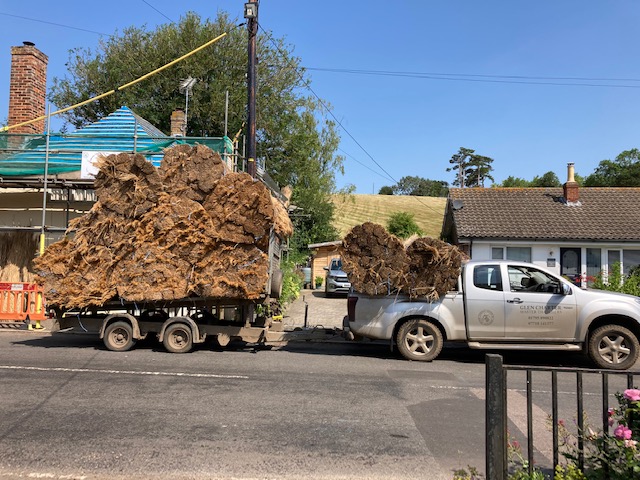
Water reed arriving ready for use in Newnham
Thatching in Kent, you may well ask? Traditionally, it is a craft usually more associated with picturesque cottages in the West Country and East Anglia. Glen quickly dispels this concept pointing out the many thatched properties around Faversham, let alone elsewhere in East Kent. Faversham Life spotted him at the end of 2021 thatching a cottage in Newnham.
On leaving school he worked as an electrician for ten years. But in his mid 20s’s, wanting a change, he cast around for a ‘trade in a niche market’ and alighted on thatching. He hasn’t looked back.
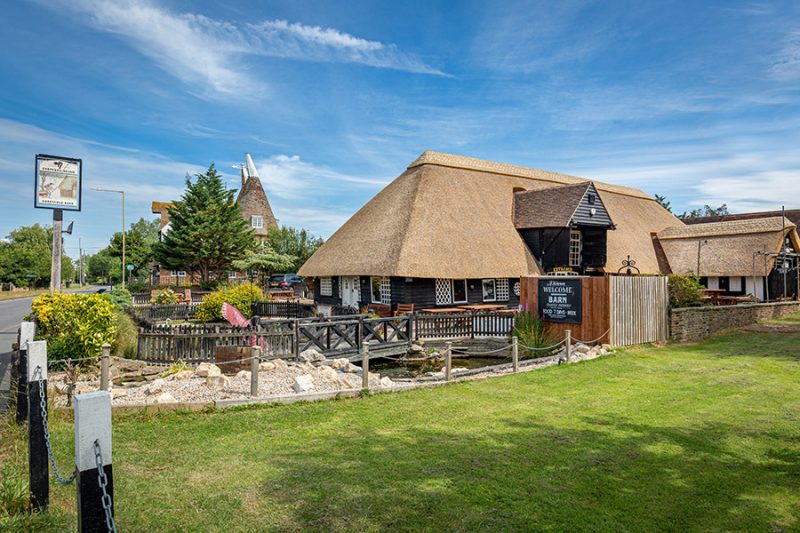
Chestfield Barn, a Shepherd Neame pub in a converted barn near Whitstable. This commission was a full rethatch with water reed and included the removal of all of the old thatch, the fitting of a fire barrier and battening
A lean vigorous looking chap, Glen has spent the past 35 years thatching largely in Kent, but also in exotic far flung climes, including Taiwan, Italy, France and America as well as all over Britain.
A member of the National Society of Master Thatchers he initially trained near Reading before returning to Kent. He then worked for a master thatcher for a while before setting up on his own. ‘Demand for thatching is strong.’ There are about 1,000 thatchers in the country.
Roofs are usually thatched with one of three different materials: water reeds, long straw or combed cereal wheat. They can also be thatched with heather but they are a scarcity in Kent. ‘I like to source straw locally if possible, buying it from Neil Ridley, a farmer in Smarden who has grown thatching straw for at least 40 years. The thatching straws are the old long short stemmed variety with small heads.’ The quality and the length of the straw is paramount. Cut with a binder it is then threshed to remove the grain, (the grain is a by-product), before being gathered into yealms. Roofs thatched with straw characteristically have a soft ‘hairy’ appearance because of the straw leaves that are often still attached to the stems along with some ears on the surface.
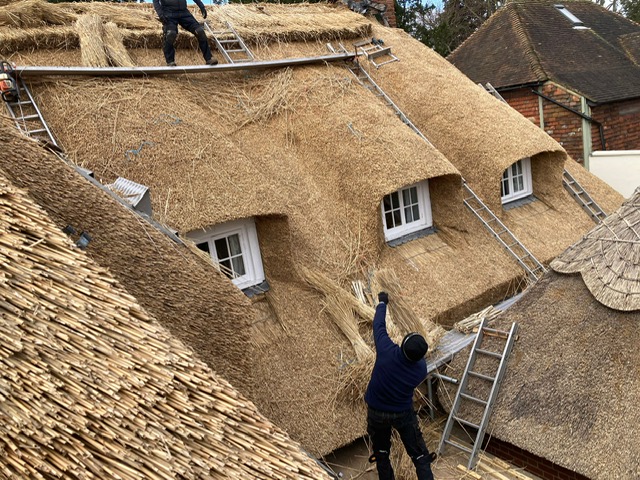
Work underway thatching a roof
Combed wheat reed straw creates a neat tight finish. This is due to the different process – the stems are combed to remove the leaf and other unwanted matter such as grasses and weeds which have crept in when harvesting. The harvesting technique, although laborious, is very important. The durability of the stems is lost if they are cut too high, thus losing the section holding the lignin content, vital for resisting early decay.
Glen keeps a small stock of materials in a rented barn for use in repair jobs. Usually, however, he gets it delivered straight to the site to avoid any chance of rodent damage that can occur in a farm environment.
It is fascinating to discover that the art of thatching has ‘barely changed’ for hundreds of years. Of course, there are regional variations that have evolved over time. For example, in Kent and East Anglia, the roof gables or ‘verges’ are vertical, whereas in the West Country they are angled back to the building.
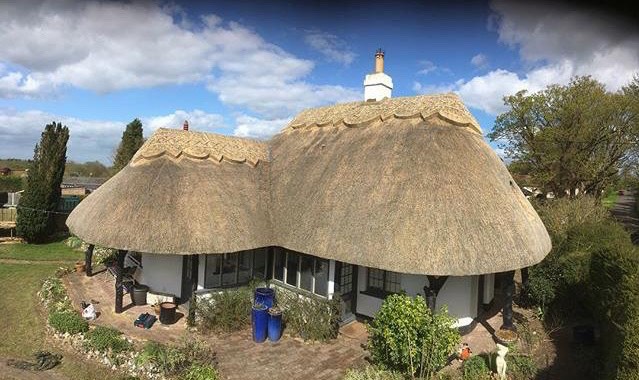
A picturesque thatched cottage sporting a decorated block ridge
Straw thatched roofs characteristically have a slightly hairy finish. The straggly ends are skilfully gathered up into ‘fancy’ block ridges’ around the eaves and gables – these are popular all over the country on thatched cottages. Hazel spars, colloquially known in some areas as ‘broaches’ are used to secure the ridges acting like hairpins. These are sometimes finished with animals or birds such as pheasants. Glen’s hallmark is a pair of doves: ‘Over the last hundred years thatched roofs have become much more ornate. I think this custom dates back to the Arts and Crafts movement’.
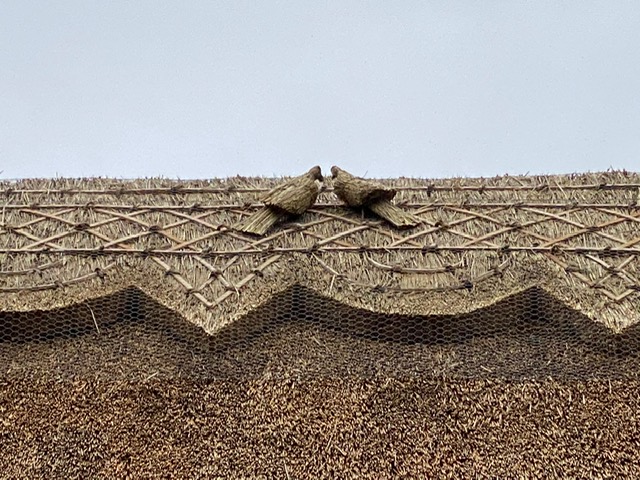
Glen’s hallmark – 2 doves
Straw roofs can be as many as five layers thick, often dating back hundreds of years. To repair an old straw roof, Glen removes the top layer and sometimes one further layer to make a solid base before re-thatching with a one-foot-thick layer.
To thatch a roof with reed is a much more complex process. First, the old roof must be stripped off to the bones, ‘the rafters’. Next, the entire roof often has to be felted and re-battened before the thatching can commence. The resulting finish is much more flat and angular than a straw roof. Glen imports his water reed from Europe, Turkey and even occasionally from China. Sometimes he will source from Norfolk, but supplies are not readily available in large quantities.
If the building to be rethatched is listed, Glen opts for the same material as the old roof, but if it is a new build he asks to the client too choose.
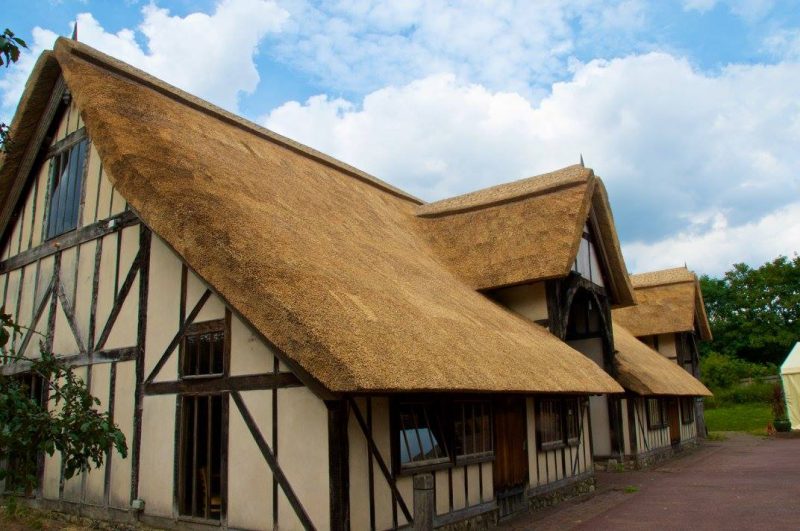
A full re-thatch of Aylesford Priory’s tea-room and restaurant. using water reed finished with a block cut straight ridge.
Thatching is proving increasingly popular and is often used for garden buildings such as pool houses and barn conversions. Among Glen’s most bizarre commissions have been a thatched bookcase and a roof for a spherical cottage for an art installation by the American artist, Lars Fisk, exhibited at the Frieze Art Fair.

Apprentice Richard Seaman atop a roof
Glen sums up the qualities needed to be a thatcher as very practical, very dextrous and above all to have a keen eye as almost every aspect of thatching is done by eye. Glen who lives in Eastling, is assisted by an apprentice, Richard Seaman,who has worked with him for four years. ‘He is very dedicated.’
How lucky Faversham is to have a master thatcher and a budding apprentice.
www.glencharterthatchingkent.co.uk